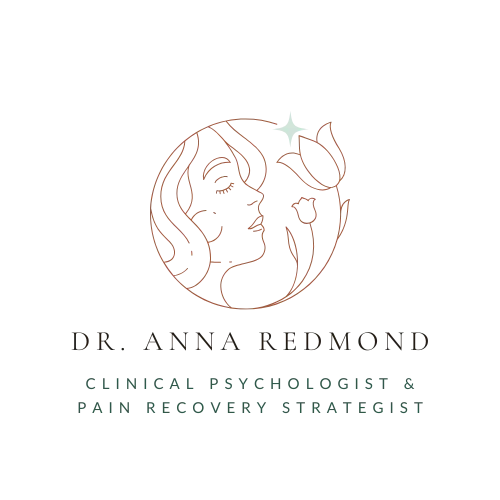Connect with me!
Tell me the number one thing that you want to understand about your pain?

Medical treatments didn’t work.
Where do you turn when medical treatments don’t work?
It makes sense that, in the acute phase of pain, we turn to the traditional medical models as our first and only course of treatment. As pain lingers on, however, taking a purely medical approach can significantly limit you.
For starters, it makes sense that if you broke your arm, you would go to the doctor and get it cast so that it can heal - regardless of your level of stress, emotional state, or amount of social support, right? If your body is treated separate from your mind, does it really matter as long as your arm heals? When pain is chronic, however, we cannot treat the brain and body as separate. We know that psychological and social factors are the other 2/3 of what makes up someone’s chronic pain experience (with biological being the other 1/3).
To ignore them would be the same as giving you only 1/3 the dose of medicine you need.
Another issue with taking a purely medical approach is that, when our doctors cant find a objective cause on diagnostic testing or if the symptoms don’t fit neatly into a diagnostic box, we can easily feel marginalized into a “somatic/psychological issue” box because they are seen as so separate. Many times, pain comes from injury. We also know from research, evidence, and probably our own experiences that pain can also occur without an initial injury.
Let’s go back to that example of a broken arm. When your doctor assesses, x-ray’s, and casts your broken arm, you really trust his expertise and passively participate in that treatment. That is the beauty of using a biomedical approach to treat acute pain. With many chronic diseases, a passive approach doesn’t work. What if we left it only up to our doctor to treat our diabetes and didn’t take any action ourselves to make lifestyle changes? You probably wouldn’t manage it very well.
Chronic pain is no different.
When you are going to a medical doctor who is an expert on medical treatment, you're likely to stand by while they do what they are an expert on. You participate passively in the treatment they recommend, the things they do TO you.
This is so different from a biopsychosocial approach to pain where you are a responsible and accountable active participant in your own treatment, being coached with education.
Taking a purely medical approach limits tools for evaluation and treatment... to only medical, physical, or biological.
But what about emotional, behavioral, social, cognitive, environmental? It leaves so much unexplained... again because you're missing the other components that contribute to your pain.
You're not talking about these other components when you’re taking a medical only approach and they are likely not a part of your treatment. Treatment for chronic pain is different from acute pain and requires a reconceptualization of your pain, and understanding of pain biology/neuroscience, and addressing those psychological and social components.
What should you do when medical treatments don’t work?
When you are willing to consider approaches beyond just medical/physical/biological, a huge window of opportunity opens up. There are so many options!
Biofeedback
Cognitive Behavioral Therapy
Acceptance and Commitment Therapy
Relaxation training
Social support
Activity Scheduling
Energy management
Pacing
Occupational therapy
Making changes to your health habits
Cognitive behavioral therapy for insomnia
Pain neuroscience education
Trauma work
Acupuncture
Tai Chi
Yoga
There are so many options outside of medicine and medical procedures and education is a great place to start (Look! You’re already here!).
3. You become a bystander to your treatment.
Think about this - when you are going to a medical doctor who is an expert on medical treatment, you're likely to stand by while they do what they are an expert on. You participate passively in the treatment they recommend, the things they do TO you.
This is so different from a biopsychosocial approach to pain where you are a responsible and accountable active participant in your own treatment, being coached with education.
4. This approach limits tools for evaluation and treatment... to only medical, physical, or biological.
But what about emotional, behavioral, social, cognitive, environmental?
5. It leaves so much unexplained... again because you're missing the other components that contribute to your pain.
You're not talking about them with a medical only approach and they are likely not a part of your treatment.
This is where education can play such a critical role.
Education provides the power to take the next step in managing your pain. You want to do the things you enjoy (or even basic daily activities) without flaring up your pain. For a limited time, you can grab my free video tutorial to get you started:
3 Simple Steps to a Balanced Day... Without the Flare-Ups.
This free video tutorial is dedicated to helping women with pain begin to find confidence to return to the moments, activities, and people they love the most.
Many of you reading this are probably not taking a medical only approach to your pain. Many of you have gathered so many resources and gotten so much education.
I'd love to hear what you're doing for your pain. What helps. What doesn't. Where you find your favorite education. DM me on instagram or send an email to anna@drannaredmond.com.
Listening to women with pain, hearing their stories, understanding their experiences - that is where I love to be and I'd love to connect with all of you!
© 2024 | Anna Redmond, LLC | drannaredmond.com
